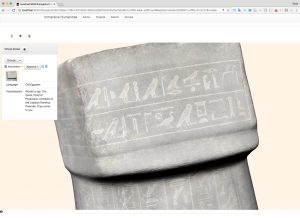Dave Shepard and Willeke Wendrich
What if instead of reading a description of an Egyptian sarcophagus, you could grab information from the object itself? The Immersive Humanities Viewer aims to make this possible. It is a web tool for tagging three-dimensional models of historical objects with rich cultural data and sharing these tagged models. The Immersive Humanities team believes that this interface will increase the visibility of historians’ work by making the experience of interacting with an object, or at least a model of an object, an intriguing search for information with many different paths to discover.

Since users will be able to define their own data schema, queries can be either straightforward (show me all swords longer than 1.20 m) or complex (show me all coffins that have Book of the Dead spell 15 on the upper half of the lid).
Since objects often have different meanings to different communities, the tool allows anyone to contribute information: for example, Native American artifacts provide evidence of cultural history to scholars and students, but play vital, living roles in Native American communities. However, such artifacts also attract significant interest from individuals who may want to add information of questionable accuracy. For this reason, we allow readers to assess the reliability of their contributions by allowing credentialing and peer review in the tool.